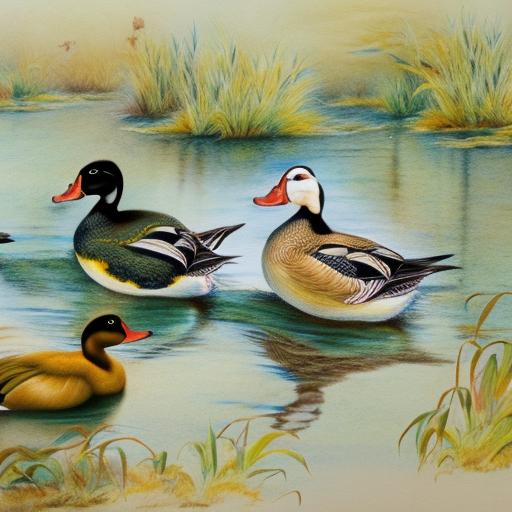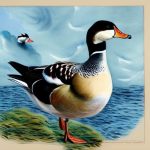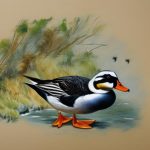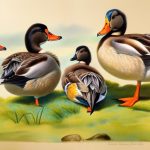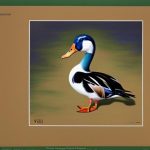Ducks are social animals that thrive in the company of others. They are known for their playful and curious nature, often engaging in activities such as swimming, foraging, and preening. Ducks are also highly adaptable creatures, capable of living in a variety of environments, from ponds and lakes to urban backyards. They are generally peaceful animals, but can become territorial during the breeding season. Understanding duck behavior is crucial when considering keeping different breeds together, as it can help prevent conflicts and ensure a harmonious duck community.
Ducks communicate through a variety of vocalizations and body language. They use different sounds to express their emotions, such as contentment, fear, or alarm. Understanding these cues can help duck owners identify potential issues within a mixed breed flock. Additionally, ducks have a natural instinct to forage for food, which can lead to competition for resources in a mixed breed setting. Providing ample space and resources is essential to prevent conflicts and ensure the well-being of all ducks involved. Overall, understanding duck behavior is key to creating a peaceful and thriving community of mixed duck breeds.
Key Takeaways
- Ducks are social animals and exhibit a variety of behaviors such as preening, foraging, and swimming.
- Different breeds of ducks have unique characteristics and temperaments, with some being more suitable for backyard settings than others.
- When housing mixed duck breeds, it’s important to provide adequate space, shelter, and access to water for swimming and foraging.
- Mixed duck breeds require a balanced diet of commercial feed, fresh water, and access to forage for optimal health and well-being.
- Potential challenges when keeping different duck breeds together include aggression, mating issues, and disease transmission, which can be addressed through proper management and monitoring.
Introducing Different Breeds of Ducks
There are numerous breeds of ducks, each with its own unique characteristics and traits. Some popular breeds include the Pekin, Mallard, Rouen, and Khaki Campbell. Pekin ducks are known for their large size and white plumage, making them a popular choice for meat production. Mallards, on the other hand, are smaller in size and known for their colorful plumage, making them a popular choice for ornamental purposes. Rouen ducks are similar in appearance to Mallards but are larger in size, while Khaki Campbells are prized for their prolific egg-laying abilities.
When introducing different breeds of ducks, it’s important to consider their individual needs and characteristics. Some breeds may have specific dietary requirements or housing needs, while others may have different temperaments and social behaviors. It’s also important to consider the compatibility of different breeds, as some may be more territorial or aggressive than others. Introducing different breeds of ducks requires careful planning and consideration to ensure a harmonious and thriving community.
Housing Considerations for Mixed Duck Breeds
When housing mixed duck breeds together, it’s important to provide ample space and resources to accommodate the needs of each breed. Ducks require access to water for swimming and bathing, as well as shelter to protect them from the elements and predators. Additionally, providing nesting boxes or areas for brooding is essential for breeds that are prone to laying eggs. When housing different breeds together, it’s important to consider their individual space requirements and social dynamics.
Creating separate areas within the housing environment can help prevent conflicts and provide ducks with the space they need to thrive. For example, providing multiple feeding and watering stations can help prevent competition for resources. Additionally, providing hiding spots or barriers can help ducks establish their own territories within the communal space. Overall, housing considerations for mixed duck breeds should prioritize the well-being and comfort of all ducks involved.
Feeding and Care for Mixed Duck Breeds
Feeding mixed duck breeds requires careful consideration of their individual dietary needs and preferences. Ducks are omnivorous animals that require a balanced diet of grains, greens, insects, and protein. Some breeds may have specific dietary requirements based on their size, age, or purpose (e.g., meat production or egg-laying). It’s important to provide a varied diet that meets the nutritional needs of all breeds involved.
In addition to feeding, caring for mixed duck breeds involves providing regular access to clean water for drinking and bathing. Ducks are highly dependent on water for their well-being, so ensuring access to fresh water is essential. Regular grooming and health checks are also important aspects of caring for mixed duck breeds. Monitoring for signs of illness or injury and providing appropriate veterinary care is crucial for maintaining the health and well-being of all ducks involved.
Potential Challenges and Solutions
Keeping different breeds of ducks together can present various challenges, such as territorial behavior, competition for resources, and potential conflicts. Territorial behavior can lead to aggression and dominance displays among ducks, while competition for resources can result in stress and malnutrition. Additionally, introducing new ducks to an established flock can disrupt social dynamics and lead to conflicts.
To address these challenges, it’s important to provide ample space and resources to accommodate the needs of all ducks involved. Creating separate areas within the housing environment can help prevent conflicts and provide ducks with the space they need to establish their own territories. Additionally, providing multiple feeding and watering stations can help prevent competition for resources. Introducing new ducks gradually and monitoring their interactions can also help prevent conflicts and ensure a smooth integration into the existing flock.
Benefits of Keeping Different Duck Breeds Together

Despite the potential challenges, there are numerous benefits to keeping different duck breeds together. Mixed breed flocks can provide a diverse and dynamic environment that promotes social interaction and enrichment for ducks. Ducks are highly social animals that thrive in the company of others, and keeping different breeds together can provide them with opportunities for socialization and companionship.
Additionally, mixed breed flocks can offer practical benefits, such as increased egg production and pest control. Breeds that are prolific egg layers can contribute to a diverse and abundant egg supply, while breeds with strong foraging instincts can help control pests in the surrounding environment. Overall, keeping different duck breeds together can create a harmonious and thriving community that benefits both the ducks and their caretakers.
Creating a Harmonious Duck Community
In conclusion, understanding duck behavior, introducing different breeds of ducks, considering housing needs, providing proper feeding and care, addressing potential challenges, and recognizing the benefits of keeping different duck breeds together are all essential aspects of creating a harmonious duck community. By prioritizing the well-being and comfort of all ducks involved, caretakers can create a thriving environment that promotes social interaction, enrichment, and practical benefits.
Ultimately, creating a harmonious duck community requires careful planning, consideration of individual needs, and proactive management of potential challenges. With proper care and attention, mixed breed flocks can provide a dynamic and rewarding experience for both the ducks and their caretakers. By understanding the unique characteristics and behaviors of different duck breeds, caretakers can create a thriving community that promotes the well-being and happiness of all ducks involved.
If you’re considering keeping different breeds of ducks together, it’s important to understand their compatibility and potential challenges. According to a recent article on PoultryWizard.com, “Can Different Breeds of Ducks Live Together?” explores the dynamics of housing various duck breeds in the same environment. The article provides valuable insights into the social behaviors, space requirements, and potential conflicts that may arise when mixing different duck breeds. For more information on creating a harmonious living environment for your poultry, check out PoultryWizard.com.
FAQs
Can different breeds of ducks live together?
Yes, different breeds of ducks can live together peacefully as long as they are introduced to each other properly and have enough space to coexist.
Do different breeds of ducks get along with each other?
In general, different breeds of ducks can get along with each other, especially if they are raised together from a young age. However, there may be some territorial behavior or minor squabbles as they establish a pecking order.
What should I consider when keeping different breeds of ducks together?
When keeping different breeds of ducks together, it’s important to consider their size, temperament, and space requirements. Providing ample space, separate feeding and watering areas, and monitoring their interactions can help ensure a harmonious living environment.
Are there any specific breeds of ducks that should not be kept together?
While most breeds of ducks can live together peacefully, it’s generally not recommended to keep large, aggressive breeds with smaller, more docile breeds. Additionally, mixing diving ducks with dabbling ducks may not be ideal as their foraging behaviors differ.
What are some benefits of keeping different breeds of ducks together?
Keeping different breeds of ducks together can provide a diverse and visually appealing flock. Additionally, it can offer a variety of egg colors, sizes, and production rates, as well as different foraging and swimming behaviors.
Meet Walter, the feathered-friend fanatic of Florida! Nestled in the sunshine state, Walter struts through life with his feathered companions, clucking his way to happiness. With a coop that’s fancier than a five-star hotel, he’s the Don Juan of the chicken world. When he’s not teaching his hens to do the cha-cha, you’ll find him in a heated debate with his prized rooster, Sir Clucks-a-Lot. Walter’s poultry passion is no yolk; he’s the sunny-side-up guy you never knew you needed in your flock of friends!

